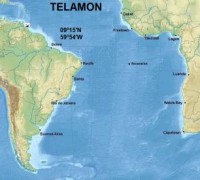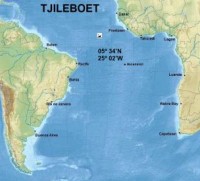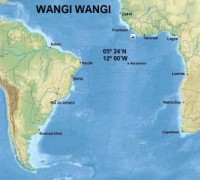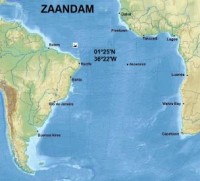SHIPS HIT NETHERLANDS 30 - DUTCH SHIPS LOST/DAMAGED/CAPTURED
28)VEERHAVEN (SUB DA VINCI)
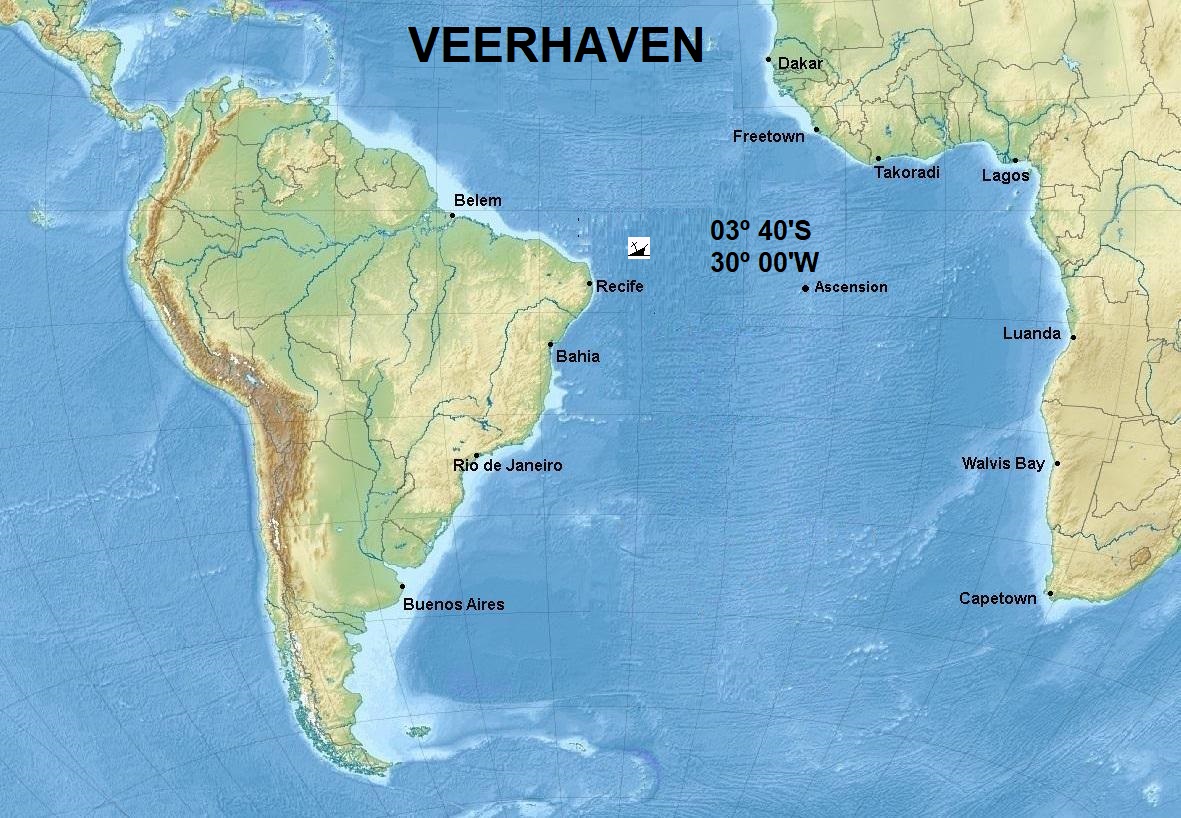
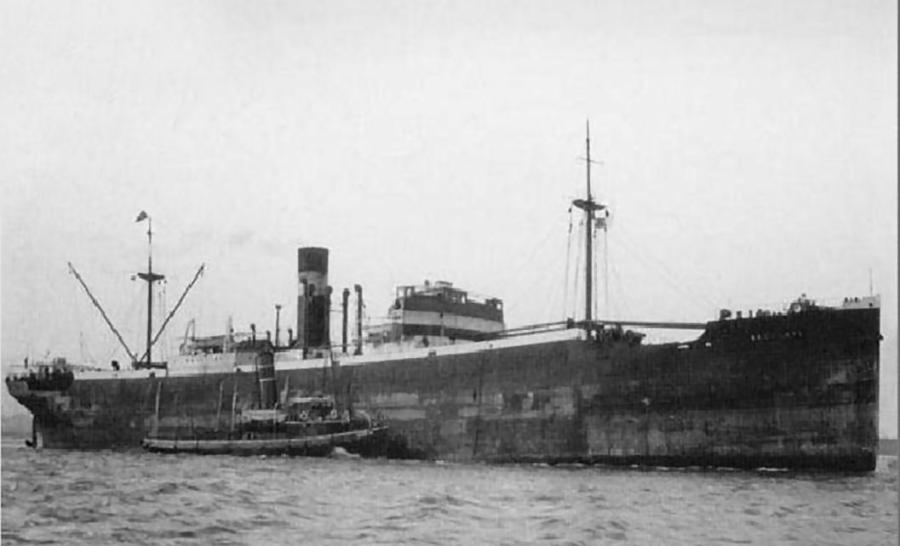
Photo. www.photoship.co.uk

Built: 1930
Tonnage: 5,291 / 9,150 tons
Cargo: Linseed.
Route: Buenos Aires - Trinidad - United Kingdom
Sunk 11 NOV 42 by Italian submarine Leonardo da Vinci on pos. 03º 40”S 30º 00”W.
0 Dead
45 Survivors
On 13/Nov/42, the Brazilian corvette Cananeia, rescued 23 survivors off Fernando de Noronha Is. and landed them at Natal in the following day. From there they picked up an ATC plane and flew to USA where they were assigned to other ships. The remaining twenty-two survivors were picked up after five days by the Argentinian tanker Juvenal.
EXCERPTS ON THE SINKING OF VEERHAVEN
BY CHARLIE MOUNTAIN
On November 10th, as we were proceeding northwards about 800 miles off Recife, Brazil, our Radio Operator received an SOS from an unidentified ship. The ship, which was apparently somewhere ahead of us, reported that she was being attacked by submarines. Our captain suspected that the message was a trick designed to lure us into a trap, so he ordered a change of course away from the other ship's position. The next day was November 11th -- Armistice Day -- and in the early morning hours I was awakened suddenly by the sound of heavy gunfire and machine gunfire. I raced up on deck, but when I arrived all I could see in the dark were brilliant flashes coming towards the port bow and port beam (the left front and side) of our ship.
The flashes were followed by explosions and fires which broke out on the ship's deck. We did not know until years later that we were being shelled by the Italian submarine Leonardo da Vinci which was under the command of the Italian ace, Lieutenant Gianfranco Gazzana Priaroggia. Da Vinci had just recently arrived in Brazilian waters with the intention of attacking Allied merchantmen, which like us, were travelling as independents, without naval escorts. Beginning with the SS Empire Zeal which Da Vinci sunk on November 2nd, the submarine had also attacked the SS Frans Hal on November 3rd, the SS Andreas on November 4th, and the SS Marcus Whitman on November 8th. Only Frans Hal had managed to escape her attacker -- Da Vinci had shot five torpedoes at the freighter, but fortunately they were all misses.
I was a member of Veerhaven's gun crew, so once I had arrived on deck I attempted to clamber up to the gun platform. But, it was impossible to get up up there because the area was being raked by machine gun bullets. Soon it became evident that there was nothing we could do to save the Veerhaven, and our captain gave the order to "abandon ship". There were two lifeboats on either side of the ship and I was assigned to the captain's lifeboat on the starboard (right) side. As we lowered the boats and were getting in them, I heard a very big bang which I thought might might have been an explosion in the engine room. The force of the explosion caused Veerhaven's funnel to lift off the deck.
Our lifeboat had a small engine as well as a sail, and as soon as we were all settled, our captain ordered the engine started so that we could pull away as quickly as possible. During all this time Veerhaven was still being fired upon, and we were lucky that neither our boat nor anyone in it was hit. When daylight came, we were all saddened when we realized that the other lifeboat which had been launched from the port (left) side of the ship, was nowhere in sight. The captain then ordered our sail to be raised and we set off for the coast of Brazil, hundreds of miles away.
That same day we saw an aeroplane, but there was no indication that the plane saw our tiny little speck on the ocean. Another day passed and then on November 13th shortly before sunset, we spotted the welcome sight of a Brazilian Destroyer heading towards us. The vessel approached us with all guns manned because in the half-dark, the crew thought that our mast might well be the periscope of an enemy submarine. When the Destroyer got closer, her crew realized that we were survivors of an Allied ship, and they soon had us all brought safely aboard. We managed to communicate quite well with our rescuers and they told us that they were out on a ten-day trial of their new American-built ship. In fact, it was the very last day before their return to port when they spotted us. We realized that we were very, very fortunate!
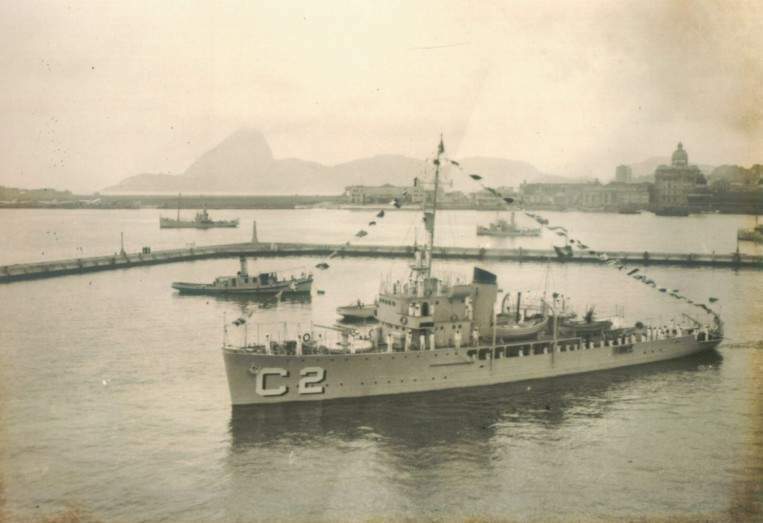
Contrary of what was said by the survivors they were not rescued by any Brazilian Destroyer but by the Brazilian corvette Cananeia, seen above. Photo. http://www.naval.com.br/ngb/C/C040/C040-f03.jpg
Our rescuers took us to one of our earlier ports of call, Natal, Brazil. Natal's location on the easternmost bulge of Brazil's coastline had turned out to be a great benefit to the Allies because it provided the shortest air route across the Atlantic to the coast of West Africa. Before its entry into the war the USA had acquired various stragetic bases throughout the Atlantic Ocean including a string of southern airfields at Puerto Rico, Trinidad, British Guiana, Belém, and Natal. By time we arrived at Natal in November 1942, the United States Air Transport Command (ATC) was keeping very busy ferrying American-built bombers and transport planes across the Atlantic and onward to the Allied forces fighting in North Africa. The amazing ATC air route eventually stretched as far as Kumming, China, over 14,000 miles from its start in Florida. After just a few days in Natal, space was found for us aboard a military DC-3 plane which was heading back to the United States.
It was a lucky thing for us that the DC-3 had been cleverly designed so that it could fly on only one engine because as we flew over the Brazilian jungle, one of our engines caught on fire. However, the loss of the engine was not a problem and we continued on to the American base on the Caribbean island of Puerto Rico where we landed safely, appropriately enough on the American holiday of Thanksgiving Day. Our damaged engine was exchanged for a new one and three days after landing at Puerto Rico we arrived at our destination of Miami, Florida.
We caught a train which took us up the American coast and deposited us 36 hours later into the freezing cold weather of New York city. But, although the weather itself was bitterly cold, I found that the people there were very warm and they made me feel very welcome. I spent a month in New York waiting for a ship and then signed on another Dutch vessel, the SS Palembang. On our way across the North Atlantic to the UK, we struck the worst storm in fifty years. I was thrown about quite badly, injuring both my knees and after we finally arrived in Liverpool, I had to spend some time in hospital recovering from my knee injuries.
In May 1943 I signed aboard the Dutch-flagged SS Aelbert Cuyp but I had to be taken off her at Hull, England and hospitalized again with a bad bout of influenza. When I was recovered I sailed again in June 1943 aboard another Dutch ship, the SS Jan Van Goyen. While Jan Van Goyen was in Boston, Massachusetts, I had the misfortune to fall down the hold. That landed me in hospital for another 10 days, but I was lucky that I only had a few bumps and bruises and nothing broken.
It was around this time I found out what had happened to the men who had been in Veerhaven's port lifeboat. During Da Vinci's attack the lifeboat was badly damaged and was in such bad condition that it would not have gotten very far. However, it was then that the signifigance of Veerhaven's linseed cargo became apparent. Veerhaven had capsized, but she did not sink right away because the linseed swelled up in the water and actually helped to seal some of the holes in her hull. When the crew in the damaged lifeboat realized that Veerhaven was going to stay afloat, they clambered up onto the upturned keel. There they remained for three days while they patched up the lifeboat as best they could. Then they set forth in the fixed-up boat and after five difficult days had the good fortune to be picked up by the tanker from the neutral country of Uruguay.
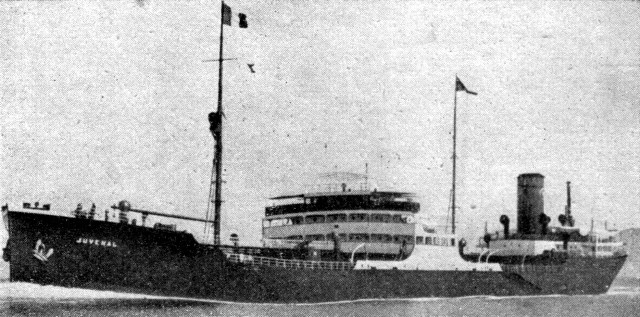
In fact they were rescued by the tanker SS Juvenal from the neutral country of Argentina seen above. Photo: Carga (histarmar.com.ar)

Italian Submarine Leonardo Da Vinci. Photo Bundesarchive. The Sinking of the SS Veerhaven (tripod.com)
